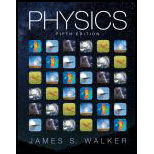
The fact that the electron has a negative charge and the proton has a positive charge is due to a convention established by Benjamin Franklin. Would there have been any significant consequences if Franklin had chosen the opposite convention? Is there any advantage to naming charges plus and minus as opposed to, say, A and B?
Answer to Problem 1CQ
Explanation of Solution
The sign convention of the charge of electron and proton is minus and plus respectively and when the charges of the electron is interchanged with each other, there is no such effect on the basic science because the total charge of the system is still zero.
The use of plus and is minus signs do have a big advantage because it shows that the system has a zero charge which means that there is an equal amount of the positive and negative charge and when the labels are opposed to A and B it becomes difficult to define the zero charge.
Conclusion:
Therefore, there are no such significant consequences if Franklin had chosen the opposite convention or not.
Want to see more full solutions like this?
Chapter 19 Solutions
Physics (5th Edition)
Additional Science Textbook Solutions
Introductory Chemistry (6th Edition)
Campbell Biology (11th Edition)
Applications and Investigations in Earth Science (9th Edition)
Concepts of Genetics (12th Edition)
Campbell Biology: Concepts & Connections (9th Edition)
Campbell Essential Biology with Physiology (5th Edition)
- 3. If the force of gravity stopped acting on the planets in our solar system, what would happen? a) They would spiral slowly towards the sun. b) They would continue in straight lines tangent to their orbits. c) They would continue to orbit the sun. d) They would fly straight away from the sun. e) They would spiral slowly away from the sun. 4. 1 The free-body diagram of a wagon being pulled along a horizontal surface is best represented by A F N B C 0 Ꭰ FN E a) A b) B c) C app app The app 10 app d) e) ס ח D E 10 apparrow_forwardPls help ASAParrow_forwardPls help asaparrow_forward
- Pls help asaparrow_forwardThe acceleration of an object sliding along a frictionless ramp is inclined at an angle 0 is 9. a) g tano b) g cose c) g sino 10. d) g e) zero A 1.5 kg cart is pulled with a force of 7.3 N at an angle of 40° above the horizontal. If a kinetic friction force of 3.2 N acts against the motion, the cart's acceleration along the horizontal surface will be a) 5.0 m/s² b) 1.6 m/s² c) 2.4 m/s² 11. d) 1.0 m/s² e) 2.7 m/s² What is the net force acting on an object with a mass of 10 kg moving at a constant velocity of 10 m/s [North]? a) 100 N [North] b) 100 N [South] 10 N [North} d) 10 N [South] e) None of these.arrow_forwardModified True/False - indicate whether the sentence or statement is true or false. If the statement is false, correct the statement to make it true. 12. An object in uniform circular motion has a constant velocity while experiencing centripetal acceleration. 13. An object travelling in uniform circular motion experiences an outward centrifugal force that tends to pull the object out of the circular path. 14. An object with less inertia can resist changes in motion more than an object with more inertia. 15. For an object sliding on a horizontal surface with a horizontal applied force, the frictional force will always increase as the applied force increases.arrow_forward
- Pls help asaparrow_forwardAnswer the given question showing step by step by and all necessary working out.arrow_forward1. The piston in the figure has a mass of 0.5 kg. The infinitely long cylinder is pushed upward at a constant velocity. The diameters of the cylinder and piston are 10 cm and 9 cm, respectively, and there is oil between them with v = 10⁻⁴ m^2/s and γ = 8,000 N/m³. At what speed must the cylinder ascend for the piston to remain at rest?arrow_forward
 Physics for Scientists and Engineers: Foundations...PhysicsISBN:9781133939146Author:Katz, Debora M.Publisher:Cengage Learning
Physics for Scientists and Engineers: Foundations...PhysicsISBN:9781133939146Author:Katz, Debora M.Publisher:Cengage Learning Principles of Physics: A Calculus-Based TextPhysicsISBN:9781133104261Author:Raymond A. Serway, John W. JewettPublisher:Cengage Learning
Principles of Physics: A Calculus-Based TextPhysicsISBN:9781133104261Author:Raymond A. Serway, John W. JewettPublisher:Cengage Learning College PhysicsPhysicsISBN:9781305952300Author:Raymond A. Serway, Chris VuillePublisher:Cengage Learning
College PhysicsPhysicsISBN:9781305952300Author:Raymond A. Serway, Chris VuillePublisher:Cengage Learning College PhysicsPhysicsISBN:9781285737027Author:Raymond A. Serway, Chris VuillePublisher:Cengage Learning
College PhysicsPhysicsISBN:9781285737027Author:Raymond A. Serway, Chris VuillePublisher:Cengage Learning Physics for Scientists and Engineers, Technology ...PhysicsISBN:9781305116399Author:Raymond A. Serway, John W. JewettPublisher:Cengage Learning
Physics for Scientists and Engineers, Technology ...PhysicsISBN:9781305116399Author:Raymond A. Serway, John W. JewettPublisher:Cengage Learning Physics for Scientists and Engineers with Modern ...PhysicsISBN:9781337553292Author:Raymond A. Serway, John W. JewettPublisher:Cengage Learning
Physics for Scientists and Engineers with Modern ...PhysicsISBN:9781337553292Author:Raymond A. Serway, John W. JewettPublisher:Cengage Learning





